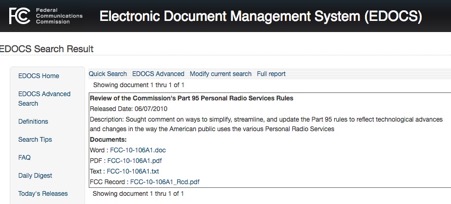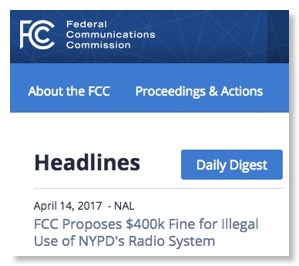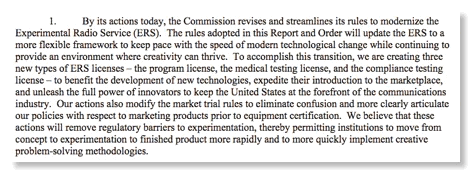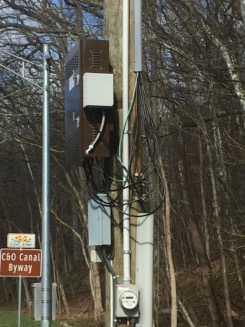More Signs of Low FCC Throughput on Spectrum Policy
The Commission has broad general power to delegate issues to its staff subject to oversight and review but the specific delegations listed in Part 0, Subpart B of the Commission's Rules probably haven't been updated in decades. Under the previous chairman there were accusations that existing delegations were abused to deprive the other commissioners, especially those of the minority party, of their "right to vote". Note that these accusation did not deal with any matters even vaguely related to the example in the TPRC paper above. We have urged a complete and thorough review of delegations along with better guidance from the Commission for the staff on general policies for handling technical spectrum policy issues that are uncontroversial.
In the previous blog post here we discussed 2 bad signs of slowness and resource limits in spectrum policy. Here are some more:
- On the agenda for the May 2017 commission meeting is an item identified as "Part 95 Reform". This is a report and order in Docket 10-119. Didn't that begin in 2010 judging from the Docket number? A quick review of EDOCS gives the result below:

There has been no FCC activity in this docket since the NPRM was adopted almost 7 years ago! A review of the comment files show some recent ex parte meetings but not a lot of controversy. Where has this rulemaking been for the past 7 years? We suspect that the 8th Floor and the WTB top leadership are so focused in net neutrality and 5G issues that other issues just get ignored. This is consistent with a contact I had with a WTB middle manager on how they might proceed with a new spectrum issue related to drones that a potential client was interested in. The middle manager said that the WTB front office had little or no interest in ANY issue that was not cellular! So the drone spectrum policy issue would probably just linger without action as all drone spectrum issues have to date.
- Another issue moving at glacial pace is Docket 13-39, an update of the FCC's RF safety rules. This is both more controversial and more significant. While traveling recently I had dinner with a fellow FCC retiree. He recently wrote me about this rulemaking saying "I started working on that project in 2003, 14 years ago!! It may outlive me!" While this rulemaking has some controversy, as indicated in our comments in the vital Wireless Infrastructure rulemaking, Docket 17-79, it is a key factor to facilitate the rapid implementation of new infrastructure. A recurring problem with local governments is whether new cell sites are safe. Pointing to rules adopted decades ago without much real updating is not very credible. So why can't FCC resolve it in time? The pending downsizing of EPA could have a real impact here since FCC and EPA share jurisdiction in this area and EPA has provided technical support on proper safety limits and how to measure them. After EPA is downsized, this rulemaking will become more difficult!
So we urge the FCC top leadership to review the overall throughput issue of FCC on spectrum policy issue and consider delegating more issues the commissioners are not personally interested in to the staff subject to policy guidelines and safeguards. This is what Ofcom does and while Ofcom's guidelines to its staff are not public, I suspect the FCC commissioners could ask Ofcom for a better understanding of how they manage their process and a few examples of guidelines for staff action.
The current FCC spectrum policy throughput problem was not created by the current chairman or his predecessor, but has built up over a decade or two. It is now time to start solving it, especially since Chmn. Pai is committed to Section 7 compliance for the first time.
Two Recent FCC Actions Highlight Chronic Concerns That Spectrum Policy Resources at FCC Are Too Low
Field Enforcement

- "On August 1, 2016, the Commission was alerted by a posting on Twitter about an unlawful intrusion on the NYPD’s radio system, whereupon the Enforcement Bureau dispatched an agent from its New York Field Office (New York Office) to confirm the intrusion and offer assistance."
- "On September 30, 2016, the NYPD contacted the New York Office and advised that it had arrested two individuals, Mr. Peralta and an accomplice, in connection with unauthorized transmissions made on the NYPD’s radio system."
Does the downsized New York FCC field office have the resources today to have helped NYPD to solve this case had they been asked?
When I was in EB's predecessor, FOB, one of the top priorities of field officer managers was to maintain good relations with local public safety officials so that they could help quickly with public safety interference issues that were of the highest priority then and well as now. So why didn't NYPD tell FCC about this case? Perhaps top FCC officials should ask why! (I suppose the FCC IG could look into to it, but we all know that unlike Curious George he is not at all curious about FCC operations that risk discovering something embarrassing to agency leaders. He is a great team player though!)
Should we look forward to this $404,166 NAL helping to reduce the national debt? Don't count on it. EB is rather evasive about how many NALs are actually paid and this type of fine against an individual has little likelihood of a substantial recovery. Perhaps a more relevant question is why this didn't result in a § 333 criminal prosecution? Now US Attorneys are reluctant to get involved in Communications Act cases involving interference to TV reception or amateur radio shenanigans, but this sounds like what § 333 was intended for and was also a criminal violation of § 301. When I worked in the old FOB, I was personally involved in 4 different successful criminal prosecutions for radio violations (2 satellite jamming cases, 1 aviation air traffic control intrusion case, and 1 maritime false distress case) during a 5 year period. It is unclear when EB was last able to ask and convince DOJ to prosecute any case, perhaps 20+ years ago? Does EB even know how to make such a request to DOJ? Does it even have the files on the old successful FOB referrals to DOJ?
Part 5 Experimental Program Licenses
On April 14th FCC's blog had a new post from OET Chief Julius Knapp entitled "Open for business: FCC's New Experimental Licensing System Accepting New Applications". It failed to mention the origins of this new program, probably because the timing might be embarrassing. On January 31, 2013 FCC adopted the Report and Order in Docket 10-236 updating the Part 5 Experimental License Program. (Note this was 26 months after the NPRM had been adopted — indicating that this docket was not exactly on the fast track. However, both the NPRM and the R&O were released on the day the Commission adopted them indicating FCC leadership was trying to maximize PR since this is treatment only PR-worthy decisions get due to perennial FCC "back office " problems. )
The R&O said about the new types of licenses:

These are all commendable goals but the 4+ years delay between the adoption of the R&O and the opening of the updated application web site that accepts applications is unexplained. There are some plausible issues dealing with a reconsideration of the R&O which was itself on the "slow track" and was slowed further by a 2 month delay in publishing the R&O in the Federal Register. OMB approval was needed for some details of the new website since it gathered information. But the most likely explanation for much of the years of delay was the lack of resources in FCC to modify the website that handles experimental applications. Indeed what was actually done was to add a new section/dashboard so that the basic experimental license website created in the 1990s remains unchanged. (It was state of the art 1990s technology in how it implemented the FCC Form 442 of the era but is a now real pain to use for even simple applications for anyone who doesn't use it on a regular basis due to design quirks and poor instructions.)
So both of these problems are probably cause by chronic low FCC funding for spectrum policy issues other than auctions and 5G. While certain FCC Title II activities are controversial, Title III activities generally are not. Indeed, Title III is both a profit center for the Treasury and a major growth enabler for the GDP. Why far the resources for FCC in this area so low that key activities are not adequately funded. Note that this is a bipartisan issue and both parties are responsible!
The WTB Auction Division is adequately funding because it can "skim" off auction proceeds. (When I was working at FCC many people noted that all the staff in the Auction Division had large displays on their PCs because their were supposedly needed for auctions - even for time clerks?) Ofcom is not funded by an appropriation from the UK Parliament, it is funded by the fees it collects subject to limits set by the agency that supervises it. Perhaps it is time to try to remove the spectrum regulation of FCC from regular politicized appropriations process since it is already supported by various spectrum fees? Recall that Wi-Fi, Bluetooth, and many other unlicensed marvels all started with a $55,652 FCC-funded study at MITRE Corporation in 1980 and today's reality is that FCC can not afford studies of new technology options and can't even afford its own spectrum enforcement activities and implementation of new rules!
Cellular Industry:
Time to Take Ownership of Part of the Wireless Infrastructure Poblem

The Commission will consider a Notice of Proposed Rulemaking and Notice of Inquiry that commences an examination of the regulatory impediments to wireless network infrastructure investment and deployment, and how the Commission may remove or reduce such impediments consistent with the law and the public interest. (WT Docket 17-79; WT Docket 15-180)
Delays in infrastructure are a major issue in spectrum policy because in reality MOST growth of wireless capacity comes from new infrastructure; the contributions of new technology and new spectrum are minor by comparison - even though both are also needed. But the FCC draft never addresses a basic issue: Why are local government slow in approving new wireless infrastructure?
Let me posit two basic reasons:
- Wireless infrastructure is often needlessly ugly and often designed with little regard for the environment around it.
- Lack of confidence in FCC's RF safety policies and resulting safety fears.

I

Should the industry have a public strategy on the aesthetics of new 5G infrastructure other than vague talk about "pizza boxes" and pictures of them held by a spokesman, not in actual installations? The proposed Mexican border wall will be generally in remote rural locations but the presolicitation published by DHS clearly states:
"Detailed requirements will be included in the RFP, but for planning we anticipate procuring concrete wall structures, nominally 30 feet tall, that will meet requirements for aesthetics, anti-climbing, and resistance to tampering or damage." (Emphasis added)
While the federal government shouldn't determine aesthetics goals for 5G, shouldn't the industry at least have publicly stated goal for this new ubiquitous addition to our urban design?
Should the public be able to see how well the industry is meeting the goal it sets?
My FCC filing does not oppose any aspect of the draft NPRM the FCC will vote on soon. It does point out that without attention to the two likely root causes of the local government delays this proceeding, like many other before it, will fail to meet its goals.

"All politics is local".
Placing ugly infrastructure on every block in America and preempting local jurisdiction in order to do this could be a good test of whether Tip's famous phrase is still true. Will it result in a major grassroots backlash if implemented as currently structured? Time will tell! Wouldn't it be better (and even more Republican) to defuse part of the problem with non regulatory approaches?
But wouldn't a better approach include voluntary action from the cellular industry with FCC encouragement to pay more attention to the physical design of its infrastructure and its compatibility with its neighbors? While in a few cases there may a need for very expensive custom designs, more attention to design basics like covering or grouping caring and use of paint to minimize the visual impact of equipment will not be major cost factors. However it will need management attention.
As mentioned at the beginning, RF safety concerns are also a factor in local resistance to wireless infrastructure. While I don't think these concerns are valid, the fact that the basic FCC RF safety rules are decades old and that the most recent rulemaking on the topic, Dockets 03-137 and 13-84, have been stalled for years shows apparent FCC apathy on the topic. FCC's partner with shared jurisdiction on RF safety is EPA and the pending severe budget cuts at that agency will make it even more difficult to update RF safety rules to keep them credible. FCC worked closely with the cellular industry to move the Spectrum Frontiers/5G docket at record pace. Both should realize that updated and credible RF safety rules are important to maintaining public confidence in wireless infrastructure - especially as it starts reaching even block in America!



![Validate my RSS feed [Valid RSS]](valid-rss-rogers.png)

